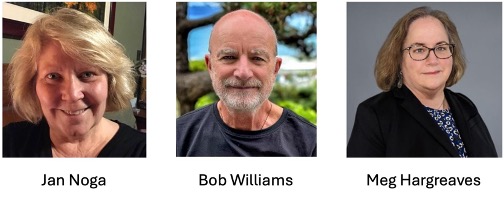Hi! My name is Jan Noga, one of the founding members of the Systems in Evaluation TIG (SETIG) and one of its first program co-chairs (with Bob Williams).
Evaluation 2024 marked the 20th anniversary of the SETIG. Returning to Portland after 18 years marked another major landmark for the TIG – our first full conference program, business meeting and inaugural Big TIG Question, and the systems concepts in evaluation anthology edited by Bob Williams and Iraj Imam.

To celebrate, the current TIG leadership team, along with Bob Williams, Meg Hargreaves, and myself, planned connected sessions to celebrate the TIG’s history and brainstorm the TIG’s future. Our session took a retrospective look back at the SETIG and the many things it has done over the years to build community, expertise, and resources for its members.
Cool Trick
We structured the session as a re-enactment of our business meetings. The roadmap for our “meeting”? Our founding, how we created identity as a systems community, how we built connection among members, and how we supported member learning over the years.

Even Cooler Trick
But, it wouldn’t have been a true re-enactment of a SETIG business meeting without the Big TIG Question. A question is posed. Prizes are involved. This year’s question – how many people attended the inaugural SETIG business meeting in Toronto in 2005? Attendees wrote down their answers. Closest answer got first pick from the prizes. Next closest (above or below) picked from the remaining prizes and so on until all the prizes were gone. It’s a great way to insert some fun and turn meetings into must-attend events.
Why Did This Matter?
Twenty years is a long time. Many members have come and gone over the years. We felt it was important to connect current members with our history so they could better understand how SETIG came to be and what brought us to where we are at present.
Reflections
Doing the session was both fun and bittersweet. It was exciting to look back and realize just how much we accomplished over those two decades thanks to the many hard-working, committed members of the TIG. We also remembered the fun – dinners and socials as a TIG, planning each year’s Big TIG question, seeing each other at annual meetings, and engaging in our different projects over the years. We laughed at how much harder some of these things were way back just due to the tech available at the time.
Each of us started as program co-chairs and then chairs, serving as many as two terms at each role. We all loved being involved with the TIG’s beginnings and found it hard to leave our leadership roles when the time came, even though we knew we were passing our torches to good hands. In fact, it struck me that, while we had always been proactive in identifying new leaders for the TIG, what we didn’t plan for was what to do with our retiring leaders to keep them involved in an emeritus role. Perhaps, something for future.
Get Involved
TIGS provide connection and community within the larger AEA membership. They are a great way to connect with new evaluators and first-time conference attendees. But, only half of AEA’s current membership belongs to even one TIG, much less multiple TIGs. If that’s you, consider joining a TIG and getting involved. If you’re already running with a TIG, recruit others who might be interested and invite them to join you. Making memories builds community, there’s no time like the present to start.
The American Evaluation Association is hosting this week with our colleagues in the Systems in Evaluation Topical Interest Group. The contributions all this week to AEA365 come from SETIG members. Do you have questions, concerns, kudos, or content to extend this AEA365 contribution? Please add them in the comments section for this post on the AEA365 webpage so that we may enrich our community of practice. Would you like to submit an AEA365 Tip? Please send a note of interest to AEA365@eval.org. AEA365 is sponsored by the American Evaluation Association and provides a Tip-a-Day by and for evaluators. The views and opinions expressed on the AEA365 blog are solely those of the original authors and other contributors. These views and opinions do not necessarily represent those of the American Evaluation Association, and/or any/all contributors to this site.
